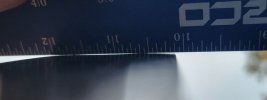I used a Blue #2 carbon gyuto (Tanaka Sekiso, convex ground) in my kitchen at home daily on a wood end grain board to prep for me and my family. I sharpened it on stones (Bester 1200/Rika 5K) at the beginning and stropped it 3 times in the next 9 months, using a balsa strop with 1 micron CBN on it. Maybe 20-30 strokes per side each of the 3 stropping sessions. After I stropped, it would still stick into the cutting board and didn't need to go back to the stones. I only went back to the stones on it after 9 months because I acid etched the blade, which killed the edge. Would have definitely gone longer with just stroppings!
10 sharpenings on stones for me would be over 10 years worth of use in a home cooking setting, but blue #2 is not known for it's edge holding compared to other steels! Unless you are chipping your knife a lot, or resetting the bevel every time you sharpen, you shouldn't be removing a ton of metal each time you sharpen. Stropping on your finest stone or leather and doing routine touch ups should preserve the factory geometry quite a while. When it doesn't perform as well, drop your angle back on your coarsest stone a bit and thin the shoulder area out just behind the edge bevel. Without a micrometer and the pictures taken at the same distance, it would be very difficult to get pictures to compare how it changes over 10 sharpenings.
If you are needing to sharpen enough that you are removing that much metal that quickly, something isn't right. Either go with a more wear resistant steel, or get a way to maintain/touch up the edge without using coarser stones. You should be able to strop a Japanese kitchen knife back to sharp several times before needing to go to the stone and you don't need to start with the coarser stones, either. I have friends who use Konosuke Fujiyama's for several years in a kitchen as their job before they need thinning out again.
With the shallow hollow grind in the main blade bevel, this helps keep the edge thin behind the edge, even with several sharpenings before it thickens up, too, so you will really need to remove a lot of steel to notice a major change in performance.
A friend sent me his buddies Shibata, which are known for being thin lasers and cutting very well. He had chipped it in several places, so I removed the chips (around 3/32" deep or so) and thinned out the area above the new edge a bit and the customer told me it performed better than before! So just because you change the geometry, doesn't mean that the performance is decreased!

